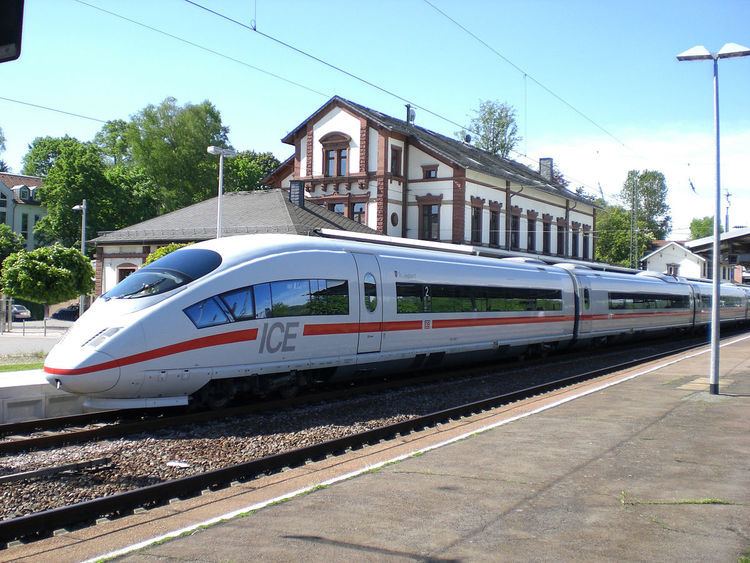 | ||
Passenger km 79.3 billion (2015, Deutsche Bahn only) Freight 75 billion tkm (2015, Deutsche Bahn only) Total 41,315 kilometres (25,672 mi) Double track 18,201 kilometres (11,310 mi) | ||
As of 2015, Germany had a railway network of 33,331 km of which 19,983 km were electrified and 18,201 km were double track. Germany is a member of the International Union of Railways (UIC). The UIC Country Code for Germany is 80.
Contents
Overview
There are around 23,500 powered rail vehicles in Germany, operated by the main operator Deutsche Bahn as well as around 1,500 smaller private railway companies:
In 2006, railways in Germany carried around 119,968,000 passengers on long-distance trains (at an average distance of 288 km), and 2,091,828,000 passengers on short-distance trains (21 km on average). In the same year they carried 346,118,000 tonnes of goods at an average distance of 309 km.
Deutsche Bahn (state-owned private company) is the main provider of railway service. In recent years a number of competitors have started business. They mostly offer state-subsidized regional services, but some, like Veolia Verkehr offer long-distance services as well.
InterRegio services, introduced in 1988 to replace the former Schnellzug and Intercity, were abolished in 2003. Deutsche Bahn is gradually increasing the percentage of InterCityExpress services, and downgrading the remaining InterCity services to the role formerly played by InterRegio.
History
German Railway history began with the opening of the steam-hauled Bavarian Ludwig Railway between Nuremberg and Fürth on 7 December 1835. The first long distance railway was the Leipzig-Dresden railway, completed on 7 April 1839. The following years saw a rapid growth: By the year 1845, there were already more than 2,000 km of railroads in Germany, ten years later that number was above 8,000.
German unification in 1871 stimulated consolidation, nationalization into state-owned companies, and further rapid growth. Unlike the situation in France, the goal was support of industrialization, and so heavy lines crisscrossed the Ruhr and other industrial districts, and provided good connections to the major ports of Hamburg and Bremen. By 1880, Germany had 9,400 locomotives pulling 43,000 passengers and 30,000 tons of freight, and forged ahead of France.
During the Second World War, austere versions of the standard locomotives were produced to speed up construction times and minimise the use of imported materials. These were the so-called war locomotives (Kriegslokomotiven and Übergangskriegslokomotiven). Absent a good highway network and trucks, the Germans relied heavily on the railways, supplemented by slower river and canal transport for bulk goods.
In 1989, the Berlin Wall fell. Train frequency rapidly increased on the existing East/West corridors; closed links which had formerly crossed the border were re-opened. On 3 October 1990, Germany was reunified; however, this was not immediately the case with the railways. Administrative and organisational problems led to the decision to completely re-organise and reconnect Germany's railways. The so-called Bahnreform (Railway Reform) came into effect on 1 January 1994, when the State railways Deutsche Bundesbahn and Deutsche Reichsbahn were formally reunited to form the current German Railway Corporation (Deutsche Bahn).
The German railways were long protected from competition from intercity buses on journeys over 50 km. However, in 2013, this protection was removed, leading to a significant shift from rail to bus for long journeys.
Platform height
The European Union Commission issued a TSI (Technical Specifications for Interoperability) on 30 May 2002, (2002/735/EC) that sets out standard platform heights for passenger steps on high-speed rail. These standard heights are 550 mm and 760 mm.
In Germany new builds are 550 mm and 760 mm. Mecklenburg-Vorpommern has new builds with 550 mm. Hesse, NRW, Berlin had new builds with 760 mm.
Rail links to adjacent countries
All these links are to countries of the same gauge, although electrification and other systems (such as signalling) may differ.
International passenger trains
It is also possible to travel to London, United Kingdom by changing onto the Eurostar at Brussels.
Railway subsidies
German rail subsidies amounted to €17.0 billion in 2014, and in 2013, 59% of the cost of short-distance passenger rail transport was covered by subsidies, although subsidies are generally not paid in the long-distance market.
